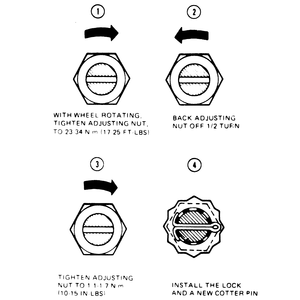- Raise and safely support the vehicle. Remove the wheel and tire assembly.
- Remove the brake caliper and suspend it aside with rope or mechanics wire;
do not let the caliper hang by the brake hose.
- Remove the dust cap and cotter pin.
- Tighten the locknut to 14–22 ft. lbs. (20–29 Nm) and turn the
hub and rotor 2–3 times to seat the bearings.
- Loosen the locknut until it can be turned by hand.
- Attach a suitable pull scale to a wheel lug bolt and measure the frictional
force.
- Tighten the locknut until the pull scale reading, the initial turning torque,
reaches the frictional force plus 1.3–2.4 lbs. Insert the retainer and
secure with a new cotter pin.
- Install the dust cap and the caliper. Install the wheel and tire assembly
and lower the vehicle.
- Before driving the vehicle, pump the brake pedal several times to restore
normal brake travel.
| Fig. 1: 2WD wheel bearing adjustment

|
- Raise and support the vehicle safely. Remove the wheel cover. Remove the
grease cap from the hub.
- Wipe the excess grease from the end of the spindle. Remove the cotter pin
and retainer. Discard the cotter pin.
- Loosen the adjusting nut 3 turns.
CAUTION
Obtain running clearance between the disc brake rotor surface and shoe linings
by rocking the entire wheel assembly in and out several times in order to
push the caliper and brake pads away from the rotor. An alternate method
to obtain proper running clearance is to tap lightly on the caliper housing.
Be sure not to tap on any other area that may damage the disc brake rotor
or the brake lining surfaces. Do not pry on the phenolic caliper piston.
The running clearance must be maintained throughout the adjustment procedure.
If proper clearance cannot be maintained, the caliper must be removed from
its mounting.
- While rotating the wheel assembly, tighten the adjusting nut to 17–25
ft. lbs. in order to seat the bearings. Loosen the adjusting nut a half turn.
Tighten the adjusting nut 18–20 inch lbs.
- Place the retainer on the adjusting nut. The castellations on the retainer
must be in alignment with the cotter pin holes in the spindle. Once this is
accomplished install a new cotter pin and bend the ends to insure its being
locked in place.
- Check for proper wheel rotation. If correct, install the grease cap and
wheel cover. If rotation is noisy or rough recheck your work and correct as
required.
- Lower the vehicle and tighten the lug nuts to 100 ft. lbs., if the wheel
was removed. Before driving the vehicle pump the brake pedal several times
to restore normal brake pedal travel.
CAUTION
If the wheel was removed, tighten the wheel lug nuts to specification after
about 500 miles of driving. Failure to do this could result in the wheel
coming off while the vehicle is in motion possibly causing loss of vehicle
control or collision.
The wheel hub/bearing assembly used on both rear- and 4-wheel drive models
is a non-adjustable component. No adjustments can be made, nor are any possible.
However, the wheel bearing can be inspected as follows:
- Raise and support the vehicle safely. Remove the tire and wheel assembly.
- Remove and properly support the caliper assembly.
- Position a dial indicator gauge against the dust cap. Push and pull the
disc brake rotor or brake drum in and out in the axial direction and measure
the end-play of the wheel bearing.
- End-play should not exceed 0.002 in. (0.05mm).
- If end-play is excessive, check the hub nut torque or replace the bearing.

